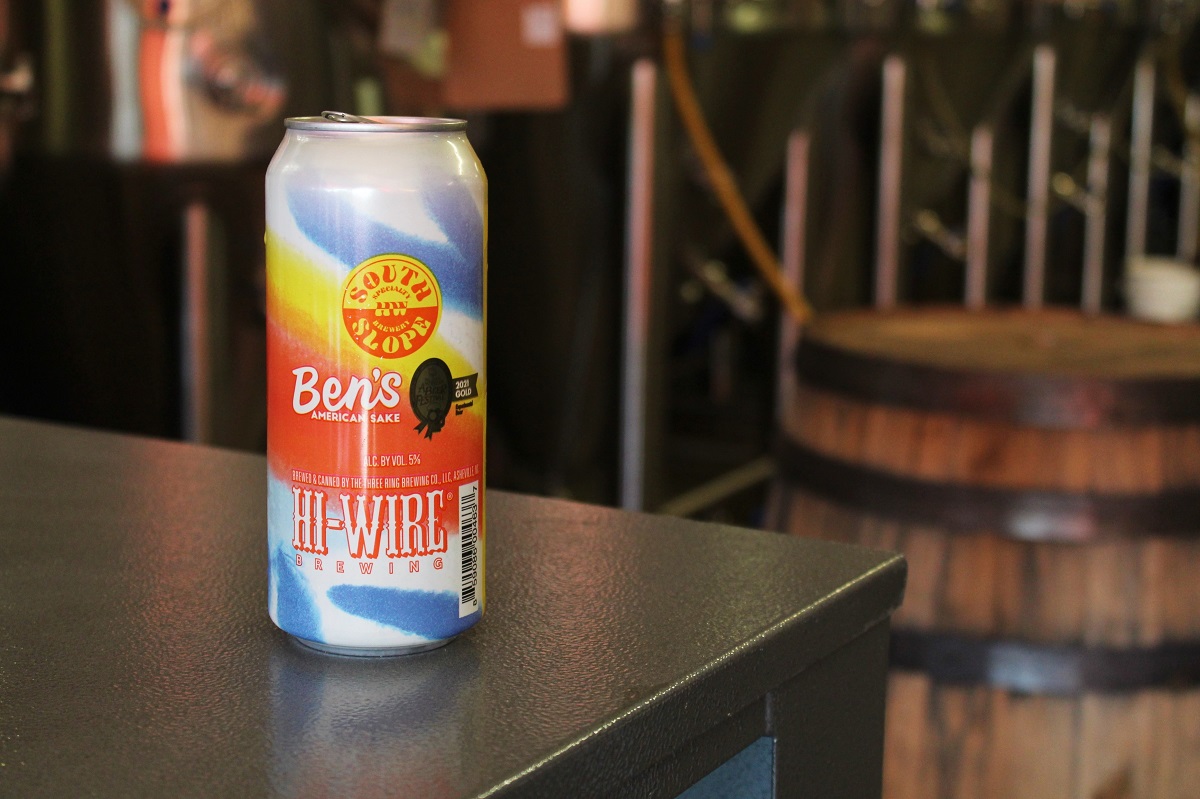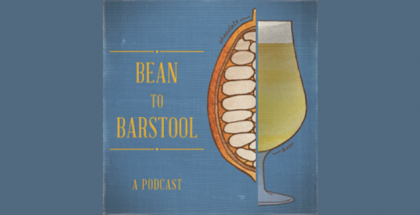World of Flavor | Sake’s Key Ingredient Unlocks New Possibilities at Hi-Wire Brewing
Hi-Wire Brewing in Asheville, North Carolina, won a gold medal at the Great American Beer Festival in 2021 for a beer its brewers weren’t even sure was going to be any good. Their Japanese Dry Rice Lager earned the hardware in the Experimental Beer category, a catch-all for anything too weird for the nearly 100 other categories judged each year. Typical winners have included an Arnold Palmer-inspired Berliner Weisse and a Sour Rye Saison aged on Prickly Pear Cactus. So what was so unusual about this Rice Lager, a beer that — on the surface — was as simple and unassuming as any beer at the festival?
The beating heart at the center of Hi-Wire Japanese Dry Rice Lager is koji, a fungus essential to the production of Sake, soy sauce, and numerous other culinary products, but something beer brewers are only beginning to explore. Hi-Wire’s winning beer is gracefully thirst-quenching — a delicious workaday beer, to be sure — but the simplicity of its execution belies the speculative nature of its creation. The beer’s genesis sprang from the friendship between Peter Batinski, head brewer at Hi-Wire’s South Slope location, and Patrick Shearer, head brewer at Ben’s American Sake right next door.
Batinski and Shearer are experimenting not with bizarre flavor ingredients but with the very building blocks of brewing — fermenters and fermentables — to expand how beer can be brewed in the first place. Koji still isn’t well-understood in American craft beer, and the pair have experienced both failures and successes as they’ve played with this historically Japanese ingredient. But they’re having fun, and they’re mapping trails for others to follow. The GABF medal hanging behind the bar is proof they’re making some excellent beer in the process.
A Background in Sake
Shearer was a homebrewer during his college years in Portland, Oregon, and planned to enter the world of craft beer soon after. He picked up a seasonal job with a winery after college, and then, as luck would have it, a Sake brewery in town announced they were looking for a full-time cellar person. He took the job at 23 years old, figuring he’d be there a couple months and learn a little bit about this Japanese beverage. He was still there five years later.
“I fell into it,” he says. “I didn’t know what Sake was. But working there, tasting fresh Sake right off the tank, it was an eye-opening experience.”

He and his wife were looking for a change of scenery when Ben’s American Sake announced they were hiring a brewer. They moved across the country to Asheville, and Shearer and Batinski, who leads the sour and specialty program at Hi-Wire, became work neighbors. They quickly got to know each other, and it didn’t take long for the pair to start discussing how they might work together. That meant figuring out how to use koji — foundational to the production of Sake — in the beer-making process. They began by brewing a barrel-aged Sour Ale with koji.
“It was the best beer we’ll never have again,” jokes Batinski.
The pair quickly learned that while using koji can lead to great results, it can also be a difficult variable to fine tune in the brewing process to achieve repeatable results. To understand why, we have to understand more about what koji is and is not.
The Basic of Koji
Strictly speaking, the word koji refers not to the fungus itself, but to the mixture of rice and fungus that allows the microorganism to grow and thrive, ready to make Sake or related beverages, such as Shochu. The fungus is from the Aspergillus family, with A. oryzae and A. luchuensis most commonly being used. These organisms are noteworthy for their ability to enzymatically break down starch and protein into simpler components, functionally creating food and nutrients for themselves where none existed.
“The number one misconception people have is that koji is what ferments Sake, and that’s not the case,” explains Shearer. “In comparison to the beer world, koji really takes the place of a mash by converting starch into sugar.”

The mash is the first step in the process of brewing beer. Malt is mixed with warm water and allowed to steep. During that time, amylase enzymes in the malt begin breaking down starches into sugars, a process that would have provided fuel for the young plant had the barley been allowed to grow as a seed. Those sugars are then fermented by yeast, most commonly Saccharomyces cerevisiae (ale yeast) or Saccharomyces pastorianus (lager yeast).
A. oryzae produces those amylase enzymes on its own, replacing the diastatic role of the mash for Sake brewers. Rather than saccharification (the conversion of starch to sugar) happening in a separate step, it happens concurrently to fermentation. Koji and S. cerevisiae are added at the same time and work side by side.
In the wild, Aspergillus fungus produces amylase enzymes to create consumable sugars for its own metabolism, and it produces a lot of them — more than it really needs. Generally there is a delay between its production of these enzymes and its own subsequent metabolism of the resulting sugars. During fermentation in a beer or Sake brewery, that lag allows Saccharomyces to step in and ferment those sugars even while Aspergillus is still converting them.
“In the Sake world, the big phrase is ‘multiple parallel fermentations,’” explains Shearer. Aspergillus and Saccharomyces stair-step through the process together.
“One of the best ways to understand what’s happening is by realizing that while sugar content is going down during a normal beer fermentation, sugar is, for a while, continuing to go up during a fermentation involving koji,” explains Batinski. “The sugar content increases until there’s nothing left to convert, and then the yeast is going to go through all of that sugar.”

Sake is made exclusively using rice as a fermentable, and how koji interacts with barley malt in beer is still being studied. When Batinski and Shearer decided to try it in a Rice Lager a few years ago, they had no idea what to expect.
“We just thought, what if we do a 50% rice and 50% two-row or Pilsner mash and just put koji in it?” says Batisnki. “I had a 10 day vacation coming up. I remember pitching the yeast and the koji into the tank and being like, I don’t know what the hell I just made, but I’ll come back in 10 days and see. And it ended up being just beautiful.”
That beer became the Japanese Dry Rice Lager that won GABF gold. The pair knew now they could create an excellent and unique beer with koji, but they didn’t yet know — and are still figuring out — what possibilities the process opens up, and how to achieve and repeat those various results.
Problems and Possibilities
The primary outcome of using koji in the award-winning Japanese Dry Rice Lager is increased attenuation (a measurement of how much of a beer’s fermentable base actually gets fermented). Batinski still performs a standard mash when working with koji, so his beer starts out with all the sugar it would need for a normal fermentation. Adding koji allows him to convert even more of the starch in the malt into sugar, which the yeast then ferments, drying out the body of the beer significantly.
Crucially, this doesn’t lead to an overly watery impression, as some of the other by-products of koji fermentation impact the beer’s mouthfeel, providing a subtly and ineffably fuller body than would be expected. The wildly increased attenuation provided by koji makes writing recipes difficult, as brewers are used to calculating final gravity and alcohol content based on standard attenuation.

“That first beer that we talked about, we were targeting 7% ABV, and we got to 12%,” recalls Pat with a laugh, adding that another beer was planned to come out at 4.5% and ended up over 7%. For the Japanese Dry Rice Lager, they’ve been able to dial it in and consistently hit 5% ABV.
In addition to converting starch, koji also enzymatically breaks down proteins and produces various organic acids, including, in some cases, citric acid. The range of variables is a lot to try to control, leading to a Pandora’s Box of both opportunity and risk.
“We don’t get head on these beers because the fungus just eats proteins and turns them back into amino acids,” explains Peter. “It’s like the Terminator, man. It just doesn’t stop.”
As Aspergillus releases its array of enzymes and metabolizes or absorbs the resulting components, unique flavor-active compounds are often produced as by-products. Determining what will be produced is tricky to predict and control.
“Koji produces so many different enzymes and it really depends on the process you’re using,” explains Aline Brito, a PhD candidate from Brazil doing research on koji through Montana State University and the School of Food Engineering at UNICAMP in Brazil. “All the conditions — the raw materials and specific processes — will influence which enzymes and how much of each the koji will produce.”

In Japanese Dry Rice Lager, Batinski is looking for a very simple, clean flavor profile, and the main influence of the koji can be found in mouthfeel — a dry, crisp body with that hard-to-describe roundness of texture, with some subtle minerality in the background. In other contexts though, the koji is clearly making its presence known more overtly in flavor.
Frontiers
Citric acid is a by-product Batinski is particularly excited about. The primary acid in citrus fruits, citric acid could potentially boost the fruity character of popular hop varieties, but the right species of Aspergillus must be used and the right conditions provided in order to yield notable citric acid.
“Aspergillus luchuensis is used in the production of Shochu and Awamori, Japanese distilled spirits,” says Brito, explaining the species produces citric acid while metabolizing glucose, a simple sugar. “The production of citric acid helps in protecting the fermentation from unwanted microorganisms. It decreases competition from other organisms that have lower tolerance to acidic media.”
Batinski and Shearer haven’t used this particular species yet, but plan to soon. Even when using A. luchuensis, the right conditions must be met, with particular temperature rests needing to be met during the growth of the mold on the rice.
Batinski is also excited about the possibilities of hop biotransformation with the use of koji. Biotransformation refers to the activity of yeast upon hop compounds during fermentation, which can lead to aromas and flavors in the finished beer that wouldn’t have existed otherwise. He recently brewed a Pale Ale with koji, and believes the array of hop aromas he got in the beer would not have been present without the koji.

“It was so unbelievably beautiful,” he recalls. “I’ve never experienced that aroma of hops in my life.”
Brito and Batinski both assume this result would come from enzymes produced by koji working on the hop compounds, but as of yet no research has been done.
“It’s surely enzymatic, but which enzymes are involved?” queries Brito. “It would be really interesting research, and I think it would be really interesting if somebody could actually get that into a lab and see what was going on.”
While Batinski and Shearer say they want to take another shot at the Koji Pale Ale, their next big task is to dial in their existing processes. Unexpected outcomes still occur, such as a curious coconut flavor in some of their koji beers (tasting through many of the Sakes Shearer has brewed at Ben’s American Sake, this subtle coconut flavor is present in several of them as well). Figuring out how to predictably produce or not produce different outcomes when working with koji is a project they’re both eager to tackle.
“If anybody else is going to experiment with this, be open-minded,” Shearer advises. “You’re not exactly in control of what the end product will be like.”
Brito agrees, explaining working with koji, yeast, and other microorganisms needs to be a collaborative process with the culture.
“You think microorganisms will do what you want, but really you need to do what they want,” she cautions. “The thing is to try to make your process the most consistent it can be.”

The GABF gold for Japanese Dry Rice Lager was just the beginning, a pleasant surprise that has Batinski and Shearer excited to learn more. They’re just getting started.
“People need to get out and try this stuff more,” says Batinski. “I would say it’s the most unique and interesting and fun thing that I’ve discovered in my brewing career so far. These are worlds of flavors that we’re discovering. It’s uncharted territory and we have never tasted anything like this before.”
All photos by David Nilsen.








Submit a Comment